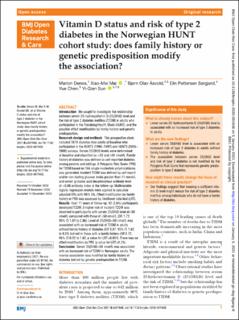| dc.contributor.author | Denos, Marion | |
| dc.contributor.author | Mai, Xiao-Mei | |
| dc.contributor.author | Åsvold, Bjørn Olav | |
| dc.contributor.author | Sørgjerd, Elin Pettersen | |
| dc.contributor.author | Chen, Yue | |
| dc.contributor.author | Sun, Yi-Qian | |
| dc.date.accessioned | 2021-02-15T14:33:35Z | |
| dc.date.available | 2021-02-15T14:33:35Z | |
| dc.date.created | 2021-01-07T10:48:27Z | |
| dc.date.issued | 2021 | |
| dc.identifier.issn | 2052-4897 | |
| dc.identifier.uri | https://hdl.handle.net/11250/2728185 | |
| dc.description.abstract | Introduction We sought to investigate the relationship between serum 25-hydroxyvitamin D (25(OH)D) level and the risk of type 2 diabetes mellitus (T2DM) in adults who participated in the Trøndelag Health Study (HUNT), and the possible effect modification by family history and genetic predisposition.
Research design and methods This prospective study included 3574 diabetes-free adults at baseline who participated in the HUNT2 (1995–1997) and HUNT3 (2006–2008) surveys. Serum 25(OH)D levels were determined at baseline and classified as <50 and ≥50 nmol/L. Family history of diabetes was defined as self-reported diabetes among parents and siblings. A Polygenic Risk Score (PRS) for T2DM based on 166 single-nucleotide polymorphisms was generated. Incident T2DM was defined by self-report and/or non-fasting glucose levels greater than 11 mmol/L and serum glutamic acid decarboxylase antibody level of <0.08 antibody index at the follow-up. Multivariable logistic regression models were applied to calculate adjusted ORs with 95% CIs. Effect modification by family history or PRS was assessed by likelihood ratio test (LRT).
Results Over 11 years of follow-up, 92 (2.6%) participants developed T2DM. A higher risk of incident T2DM was observed in participants with serum 25(OH)D level of<50 nmol/L compared with those of ≥50 nmol/L (OR 1.72, 95% CI 1.03 to 2.86). Level of 25(OH)D<50 nmol/L was associated with an increased risk of T2DM in adults without family history of diabetes (OR 3.87, 95% CI 1.62 to 9.24) but not in those with a family history (OR 0.72, 95% CI 0.32 to 1.62, p value for LRT=0.003). There was no effect modification by PRS (p value for LRT>0.23).
Conclusion Serum 25(OH)D<50 nmol/L was associated with an increased risk of T2DM in Norwegian adults. The inverse association was modified by family history of diabetes but not by genetic predisposition to T2DM. | en_US |
| dc.language.iso | eng | en_US |
| dc.publisher | BMJ Publishing Group | en_US |
| dc.rights | Navngivelse-Ikkekommersiell 4.0 Internasjonal | * |
| dc.rights.uri | http://creativecommons.org/licenses/by-nc/4.0/deed.no | * |
| dc.title | Vitamin D status and risk of type 2 diabetes in the Norwegian HUNT cohort study: Does family history or genetic predisposition modify the association? | en_US |
| dc.type | Peer reviewed | en_US |
| dc.type | Journal article | en_US |
| dc.description.version | publishedVersion | en_US |
| dc.source.volume | 9 | en_US |
| dc.source.journal | BMJ Open Diabetes Research & Care | en_US |
| dc.source.issue | e001948 | en_US |
| dc.identifier.doi | 10.1136/bmjdrc-2020-001948 | |
| dc.identifier.cristin | 1866880 | |
| dc.description.localcode | http://creativecommons.org/licenses/by-nc/4.0/ This is an open access article distributed in accordance with the Creative Commons Attribution Non Commercial (CC BY-NC 4.0) license, which permits others to distribute, remix, adapt, build upon this work non-commercially, and license their derivative works on different terms, provided the original work is properly cited, appropriate credit is given, any changes made indicated, and the use is non-commercial. See: http://creativecommons.org/licenses/by-nc/4.0/. | en_US |
| cristin.ispublished | true | |
| cristin.fulltext | original | |
| cristin.qualitycode | 1 | |

